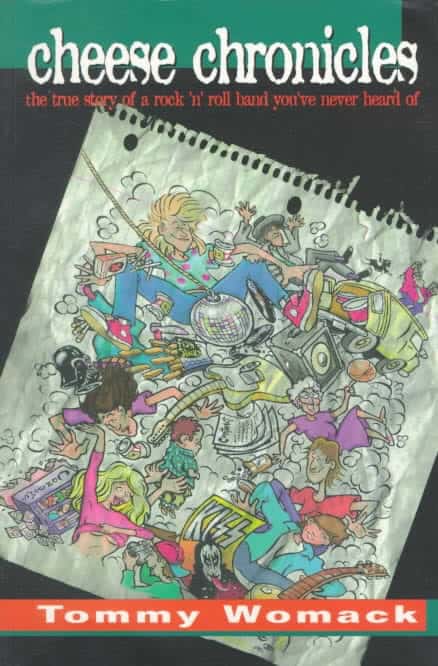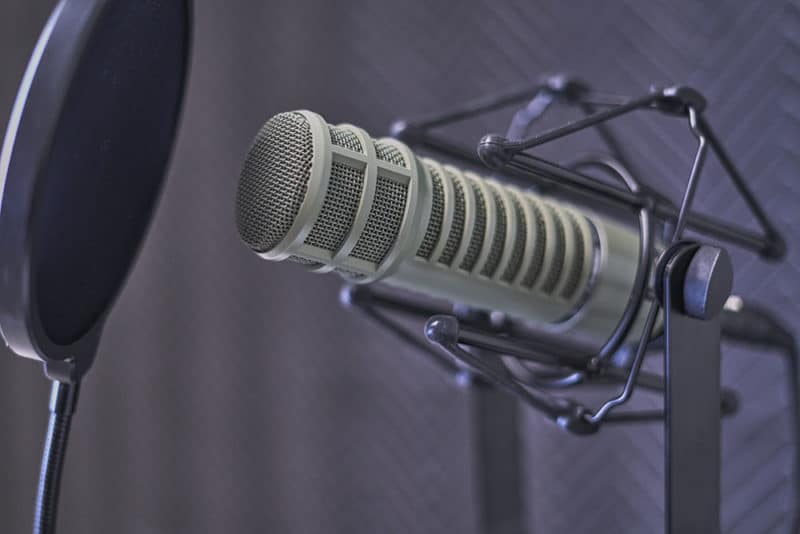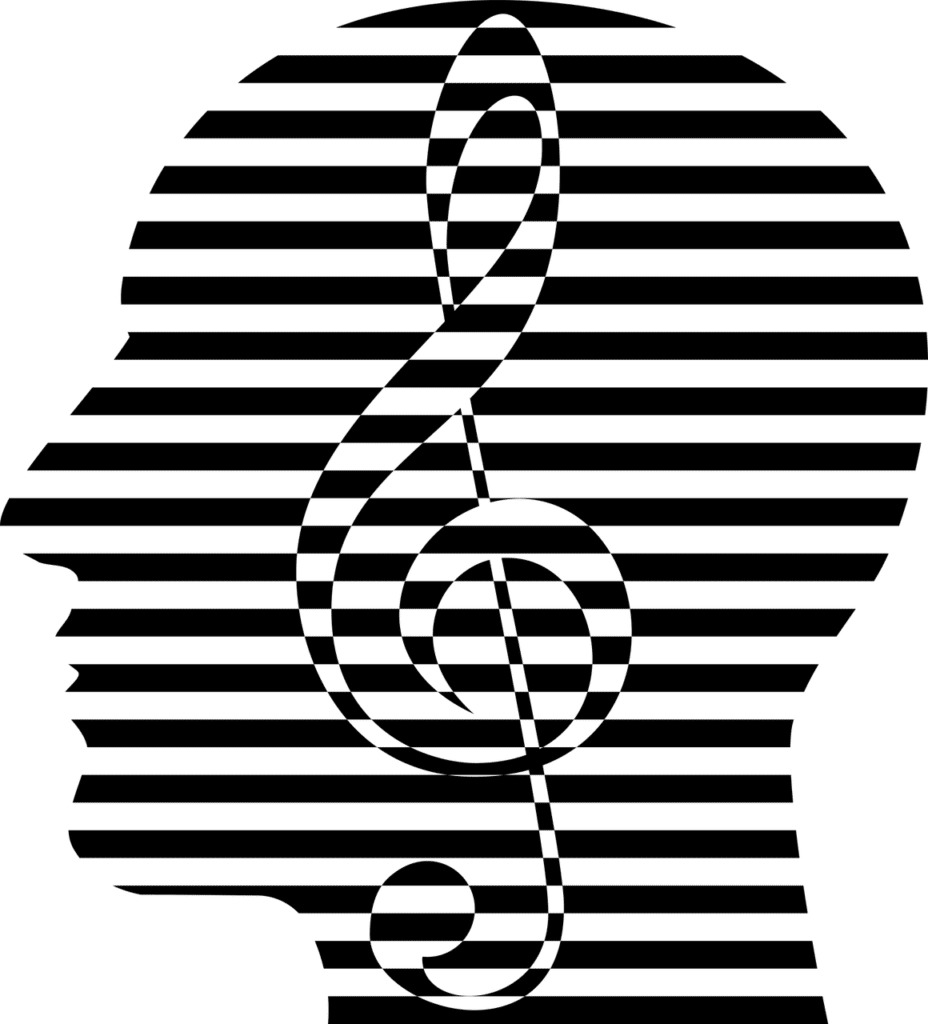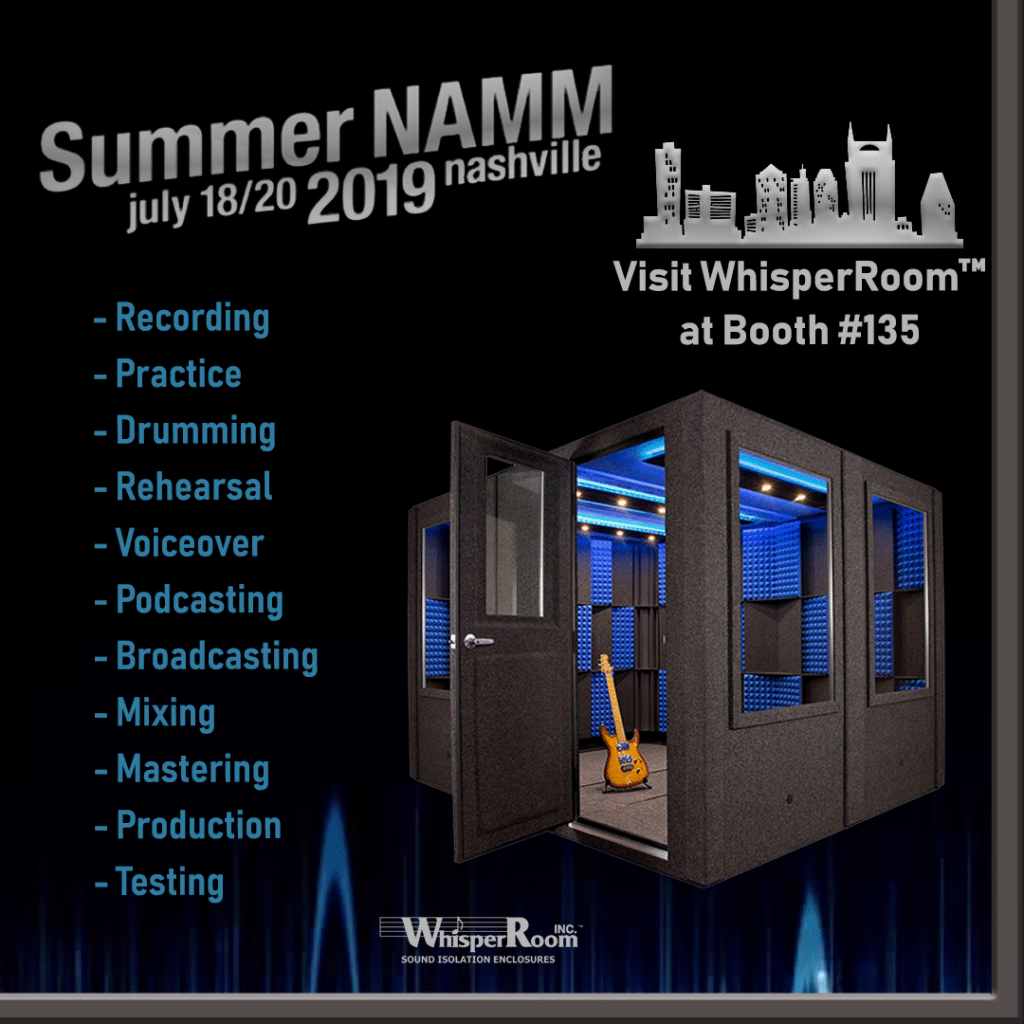WhisperRoom™ is a proud sponsor of the podcast Recording Studio Rockstars. In each episode, Lij Shaw interviews music producers, engineers, studio owners, and other professionals to bring you inspiring stories, tricks, and insight from the recording industry.
You can listen to the entire podcast archive of Recording Studio Rockstars here or from your favorite podcast app.
RSR Episode #213: Tommy Womack
In this week’s episode of Recording Studio Rockstars, Tommy Womack talks about his 80s rock band Government Cheese, writing with acoustic vs. electric guitars, becoming an author, and how to know a good song from a bad one – and then finish it.
Listen to the full episode here or stream it in the video below!
Up Close with Tommy Womack
Tommy Womack is a singer-songwriter, author, humorist, and Kentucky native. Tommy got his start in 1985 to 1992 with legendary Bowling Green-based post-punk and college radio faves, Government Cheese (whose story is immortalized in Tommy’s cult classic book “Cheese Chronicles“).
Upon moving to Nashville in 1992, Tommy became known for his long working relationship with Will Kimbrough. Their band the Bis-Quits put out an album on John Prine‘s label ‘Oh Boy‘, and their band Daddy has made two albums and enjoy a cult following.
Since 1998, Tommy has released seven solo albums with the latest being the brand-new “Namaste“. In addition to his new music, Tommy is known for his past hits “Nice Day”, “Vicky Smith Blues”, and “Alpha Male & the Canine Mystery Blood”.
Check out his 2012 performance of “90 Miles an Hour Down a Dead-End Street” live at Music City Roots in the video below.

Tommy Womack as an Author
“Cheese Chronicles” isn’t the only book written by Tommy, he is the author of the comic Civil War novella “The Lavender Boys & Elsie“, and the recently published “Dust Bunnies“. He has written for many magazines, including the Oxford American, and is a regular contributor to The East Nashvillian.
Tune In Weekly
Subscribe and tune in weekly so you never miss an episode of Recording Studio Rockstars. Download every episode here.
5 Tips for Tracking VocalsIn a recording session, the term “tracking vocals” denotes the specific task of recording the singer’s voice onto an individual track. This task stands out for its complexity and fine-tuning, with each vocalist requiring a unique approach. Guided by a clear objective – the optimal vocal performance – the tracking process strategically aligns each action in the session towards this desired outcome. Therefore, when you hear “let’s track the vocals,” it specifically pertains to the focused effort of capturing only the vocal performance.
If you’re recording voice-over for a commercial, the steps involved and the equipment utilized will likely be very different than if you are laying down tracks with an opera diva or the singer of a punk-rock band.
Whatever style you’re recording, you’ll want to use every tool in your bag to tease out the best result possible. Vocal tracks are at the sonic forefront of every mix, and nothing will sink your final project faster than sloppy or hastily-recorded vocals. Here are 5 tips to keep in mind as you record.
1. The Right Space
Few things will affect your vocal recordings as much as room choice. It’s best to have a silent and acoustically treated environment to track your vocal in. Recording studios have different rooms because the size, shape, and surface of each room affect the sounds that are being produced.

Recording at Home
When recording at home, be aware that furnished, carpeted rooms of medium size will achieve warmer-sounding vocals while spare, reflective rooms (those with tile or other smooth surfaces) will add unwanted amounts of natural reverb to your recording.
Depending on where you’re at in your career and how often you record, you might consider investing in a soundproof booth for your professional home studio.
If so, a WhisperRoom™ isolation booth is a versatile option that will consistently provide you with an excellent recording environment. Our sound booths are modular and expandable, so you can easily relocate or upgrade when necessary. We offer 26 different sound booth sizes – check them out!
2. Choice of Microphone
Of course, microphone choice will affect your recording. While there are many types, condenser mics, and dynamic mics are the two most popular for tracking vocals. The major difference between them is the output level.
Most vocals are recorded with condenser mics, which come in small and large diaphragm models. Dynamic mics have a lower output and are therefore perfect for recording instruments that are already loud.
With very few exceptions, small-diaphragm condenser mics are preferable to the large-diaphragm style for recording vocals. This is because small-diaphragm mics follow sound waves more accurately and consistently than large-diaphragm mics.
Since so many mics are on the market, it’s helpful to know what to look for before you make a purchase. Check out the video below to help you choose the right microphone.
3. Microphone Placement

Most rooms have what is referred to as a “sweet spot” where recording produces the best results. The rooms in your home have sweet spots too. Experiment with recording in different areas of your space. Avoid the center of the room and don’t get too close to the walls– other than that, try recording everywhere!
Proximity to the Microphone
When tracking vocals, a performer’s proximity to the mic will also affect the tone and levels of the recording. While different microphone types have different suggested distances there’s no hard-and-fast rule. Simply move closer to or further from the mic to achieve your desired result.
Positioning the Microphone
Microphone position relative to the vocalist will influence the result of your recordings too. A mic positioned horizontally to the mouth is considered to be in the default position. Lowering and tilting the mic upward toward the vocalist will achieve a brighter sound. Aiming the microphone downward toward the vocalist will accentuate the lower end.
4. Vocal Performance
In the age of cut-and-paste, auto-tune-capable digital recording, it’s imperative we don’t let the machines do the heavy lifting for us. “We’ll fix it later” may be an okay sentiment for songwriting or recording scratch tracks, but never for professional recording.
Digital effects are spices, not ingredients. They should be used sparingly to bring out the flavor of a track. No amount of salt will make a lousy meal taste better, and no amount of reverb will compensate for a lackluster vocal performance.
Whether you’re capturing the bittersweet strains of a country ballad or recording dialog for an audiobook, you have to make the listener believe. Because emotion plays so vital a role in vocal performance and recording, it’s a good idea to use lighting and atmosphere to your advantage.
It may seem cliche, but make sure to set the “vibe”. You’d be surprised how dimming the lights can change the mood in a room. Conversely, for a higher-energy recording, brighter lighting should be used.
Timing and tone are both integral to achieving solid vocal performances. As such, record as many vocal tracks as necessary, then record a few more. Double tracking or carefully combining multiple tracks will help highlight subtle nuances in your performance.
5. Record “Dry”
Finally, leave the effects for last and use them sparingly. Record your tracks “dry” (without any effects) so you can better hear the nuances of each take.
Different people have different recording techniques, but we believe it’s a “best practice” to record vocals without any effects – unless you are stylistically trying to achieve a certain sound.
Final Thoughts
Follow and experiment with the suggestions listed above and chances are you’ll be amazed at the difference in the quality of vocal recordings you’ll produce!
Perfect Pitch vs. Relative Pitch: Which Can You Learn?Seasoned singers, audio engineers, voice actors, and musicians have all developed highly specialized abilities for understanding music and recognizing pitch. When most people refer to someone as having a “perfect ear,” they often confuse learned musical ability with a phenomenon called “perfect pitch.” Let’s look at the difference between perfect pitch vs. relative pitch.
What is Perfect Pitch?
Perfect pitch, or absolute pitch, is the ability for a person to instantly recognize any random musical tone that they hear. This is the most notable difference between perfect pitch and relative pitch. However, perfect pitch is rare in the Western world where less than one in every 10,000 people has this ability.
For many years, scientists believed that perfect pitch was a strictly inborn ability. Later, the nature versus nurture debate about perfect pitch heated up with the release of scientific studies that suggested that perfect pitch could be learned.
Populations in some Asian communities have dramatically higher instances of perfect pitch than in Western countries. At first, researchers thought that this variance derived purely from genetic differences. However, recent studies of Asian populations who grew up speaking a tonal language suggests otherwise. In the study, participants who spoke “very fluent” mandarin scored much higher than all other participants.
In tonal languages, words can have completely different meanings depending on the musical tone in with they are spoken. Children who learn a tonal language from a young age learn to differentiate between more subtle changes in tone than children who speak non-tonal languages.
Can the Perfect Ear be Developed?
Perhaps perfect pitch can be learned, but it takes an incredible amount of time and effort. The ability is difficult to obtain unless you learn it before the age of four when the part of the brain associated with acquiring verbal skills develops rapidly.
Some adults have attempted to learn perfect pitch with varying levels of success. They have employed various methods such as:
- Drilling individual notes – this technique involves listening to a note repeatedly and associating the sound with the note name.
- Assigning other qualities to the note – studies have shown that many people who have inborn perfect pitch also possess an ability called “synaesthesia.” People with synaesthesia automatically associate stimuli in one sense modality with elements of a completely different sense. For example, they might always see an “A-flat” as light orange.
- Listening to individual notes on various instruments – Different musical instruments have distinct tonal qualities. This can help a person who wants to learn perfect pitch by teaching him or her to differentiate between the pitch and the timbre of a note.
While it may be theoretically possible to develop perfect pitch, its practical use is debatable. Conversely, relative pitch is an essential ability for musicians to learn.
What is Relative Pitch?
Relative pitch is the ability to distinguish the difference in pitch between two notes. This ability allows musicians to know when they are out of tune relative to other musicians or the song they are singing or playing.
After years of practice, seasoned musicians develop the ability to distinguish the different intervals between two notes, to identify chords based on the individual tones being used and to recognize the sounds of various chord progressions.
Ways to Learn Relative Pitch

Developing the ear for relative pitch remains a key element in every musician’s training. For example, private tutors and university professors use a variety of methods to help students develop their relative pitch, including:
- Teaching solfege – solfege assigns different note names for each degree of the major scale. With practice, a student can learn the different solfege names that correspond with each interval.
- Employing interval trainer apps – students can use computer programs to drill intervals between notes.
- Assigning reference songs – Music teachers can assign reference songs so that students can learn intervals. For example, singers might study “Somewhere Over the Rainbow” to learn an octave leap.
- Teaching triads – Each chord is comprised of a triad. Learning triads helps students distinguish among individual notes and chords.
- Teaching with chordal instruments – Most university programs require that students learn to play a chordal instrument like the guitar or piano. This helps students to develop several important abilities, including relative pitch.
You can see, developing relative pitch is an integral part of any musician’s journey. With daily practice, music students can develop this important ability in a fairly short time.
A Combined Musical Language
Rather than focusing on perfect pitch vs. relative pitch, it’s more beneficial to view the two skills as a complementary whole.
Perfect pitch and relative pitch are two individual hearing skills that each have unique capabilities. When combined, the two skills will give you a complete understanding of the notes, melodies, chords, harmonies, and progressions that are happening in the music. For example, relative pitch lets you know that you hear a Minor Seventh chord while perfect pitch tells you the exact notes that are being played in the Minor Seventh chord.
As you work on perfecting your ear’s ability to detect pitch, keep in mind that WhisperRoom™ offers 26 different sized practice rooms so you can work on skills in a noise-free environment.
Want to Become a Recording Engineer?It’s not a starring role, but the show can’t go on without it.
If you’re seriously considering how up to become a sound engineer – also known as an audio engineer or recording engineer – you’re signing up to be one of the unsung heroes of the world’s most popular and mysterious industries. Essentially, a career as a recording engineer gives us ordinary people the chance to work in two of America’s most glamorous industries…
Music and film/television.
What Does a Recording Engineer Do?
That’s like asking what a painter does. The two do the same thing, except the recording engineer paints with sound.
Okay, let’s unpack that.
Audio engineers are paid to capture sound and use it to translate ambiguous ideas (read: emotions) into sounds that perfectly compliment the final product. 9 times out of 10, that product will either be music, film, or a television show.
To accomplish such an artistic feat, recording engineers must have complete command of the technology and equipment used to capture and produce sound. They also need to have an appreciation for sound and how it shapes the human experience.
7 Tips to Become a Better Recording Engineer
But how do you build the skills you need for this kind of career in audio production?
We thought you’d never ask. Here are seven tips to help you grow your skillset:
1. Teach Yourself
It’s never been easier to be self-taught than it is right now.
The internet (specifically Youtube) has created a free market for everyone to learn virtually any practical skill in less than an hour. With platforms like Skillshare, Udemy, and other e-learning options, information from any industry has never been more accessible.
It’s also a great time to be an aspiring recording engineer. Most of the technology and equipment used for audio production are now software-based and thus much more affordable than previous industry-standard equipment.
What does that mean for you? It means for an affordable price, you can experiment with Logic, ProTools, Ableton Live, and many others. Experimentation alone won’t make you a professional, however.
You have to learn the craft behind your art form. You can do that by upping your musical IQ. The theory of sound and digital audio production, among other things, are basic skills that you might want to teach yourself to elevate your game and be seen as a knowledgeable professional.
2. Find a Mentor or Internship
There many ways to learn and master a craft, but the quickest way is to find a mentor. Mentors are a great way to cut your learning curve in half or more. With all their knowledge and experience at your disposal, you’re in prime position to get a head start at mastering your craft.

How to Find Mentors:
- Social Media
- Trade Shows / Conferences
- Music Festivals / Showcases
- Your local studios
Check out this article on how to land a mentor once you find one. No, you can’t just ask. There’s an etiquette to this.
3. Work for Free
Sometimes to make money, you have to work for free.
Counter-intuitive as that may sound, it’s the truth. When you’re new to any industry, your biggest obstacle is obscurity. No one knows you yet. Nobody knows your work, and no one knows what you’re capable of.
And no one cares.
And they’ll continue not caring until you show them your value.
How do you do that?
Free work.
There are additional benefits to working for free when you’re a recording engineer. It allows you to build valuable relationships with local musicians, who may go on to become regular clients or help you get your foot in the door with major labels and studios.
4. Go to School for It
If all else fails, get a degree.
When considering this route, make sure you do a hefty amount of research. You need to make sure the program you’re entering into has a solid reputation for hands-on education. If you lack connections to mentors or industry pros you can learn from directly, a school may be a good option.
5. Learn to Play Some Instruments
Playing an instrument doesn’t just score cool points with the ladies.
It also really helps develop your game as a recording engineer. If for nothing else, learning to play an instrument will teach you to see music from your clients’ perspective. That will give you the ability to speak a shared language during those long studio sessions.
Here are some tips that will help you boost your musical ear.
6. Understand the Industry
Change is the only constant in life.
Everything else is in a constant state of flux. You can bet that’s true for every industry, but especially music. The music industry has seen some of the most devastating disruptions over the past few decades from the rise and fall of CDs into the new streaming era.
If you want to do well as a recording engineer you’ll need to stay on top of the latest technology, trends, styles, and sounds that govern your craft.
7. Network, Network, Network
For some you, this is the scary part.
It’s also the part that gives you the most bang for your buck. Aside from spending time honing your craft, all of the above tips can be accomplished by networking.
Audio engineering is as much about who you know as it is what you know.
The more people that know who you are and what you can do, the further your career advances. Remember, when you’re starting, your biggest obstacle is obscurity. Networking is the biggest and baddest weapon in the fight against obscurity.

It’s Not a Job, It’s a Lifestyle
Looking for fame, fortune, and debauchery?
Audio production is, quite frankly, the last place you should look. The music industry is famous for its intoxicating veneer of over-sexed glamour and anti-establishment charm.
The truth is, it’s just as precise and even mundane as your basic office job. Audio engineer and record producer Tim Dalton puts it best, “You may get to wear skinny black jeans and Converse to work, but this doesn’t mean that you are working any less than your friends who have to wear a suit and tie to work in their office.”
The fact of the matter is that even though the product you’re selling is music, you’re still selling a product. And selling requires work.
In most industries, standing out requires spending long hours in high-stress, ultra-competitive environments. The music industry is no different.
Still wondering how to become a sound engineer?
To do it, you have to live it. To live it, you have to love it. Otherwise, grab a suit and tie and head for your nearest 9 to 5.
WhisperRoom™ to exhibit at Summer NAMM 2019 in Nashville, TN

Summer NAMM 2019 – the world’s largest trade-only event for music products, music tech, and pro audio is taking place in the heart of Nashville next week. Find us in booth #135 at the Music City Center. Stop by to see and test out an MDL 4896 E (4′ x 8′ double-walled) room.
When: July 18 – 20, 2019
Where: Nashville Music City Center | 201 5th Ave S | Nashville, TN 37203
Meet some of our team and test out select models while you’re there.
With more than 14,000 registrants and 1,650+ brands, Summer NAMM is the perfect time to see the industry’s latest products and network with industry professionals. Get direct access to music retailers, top school band & orchestra dealers, hundreds of independent stores, leading media, and industry influencers. Just in time for the busy back-to-school and holiday season. Visit namm.org for more information.
We’ll see you there!





